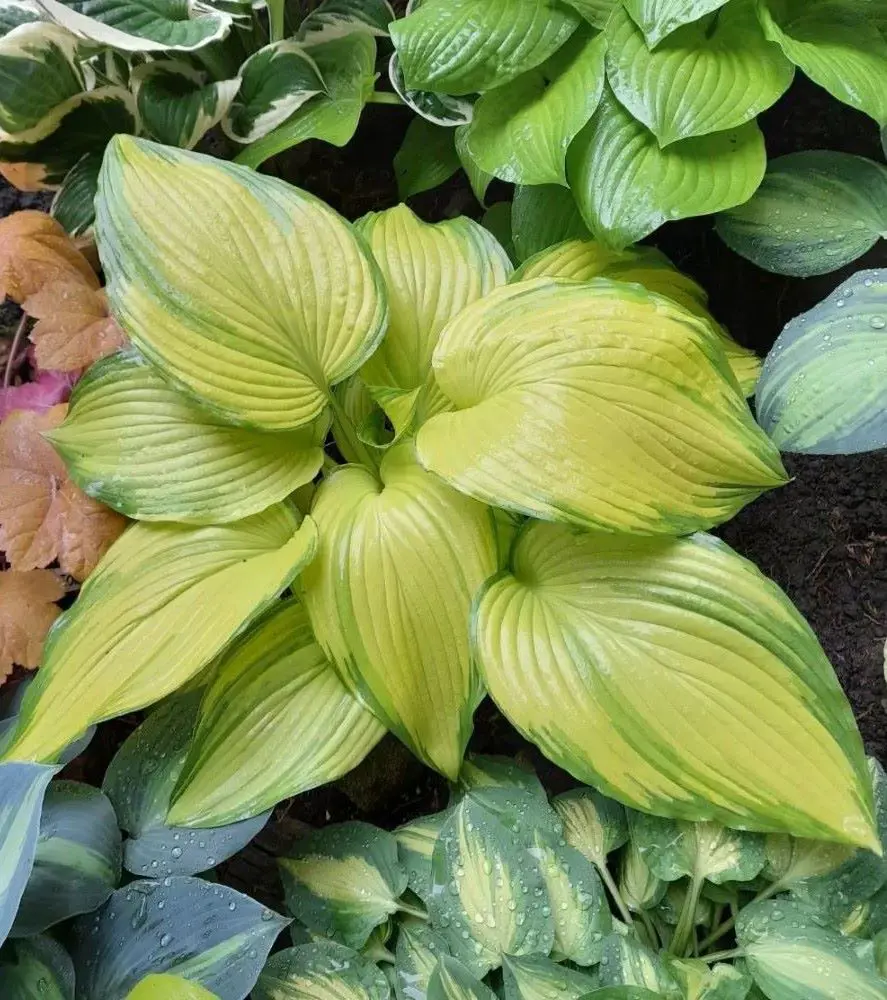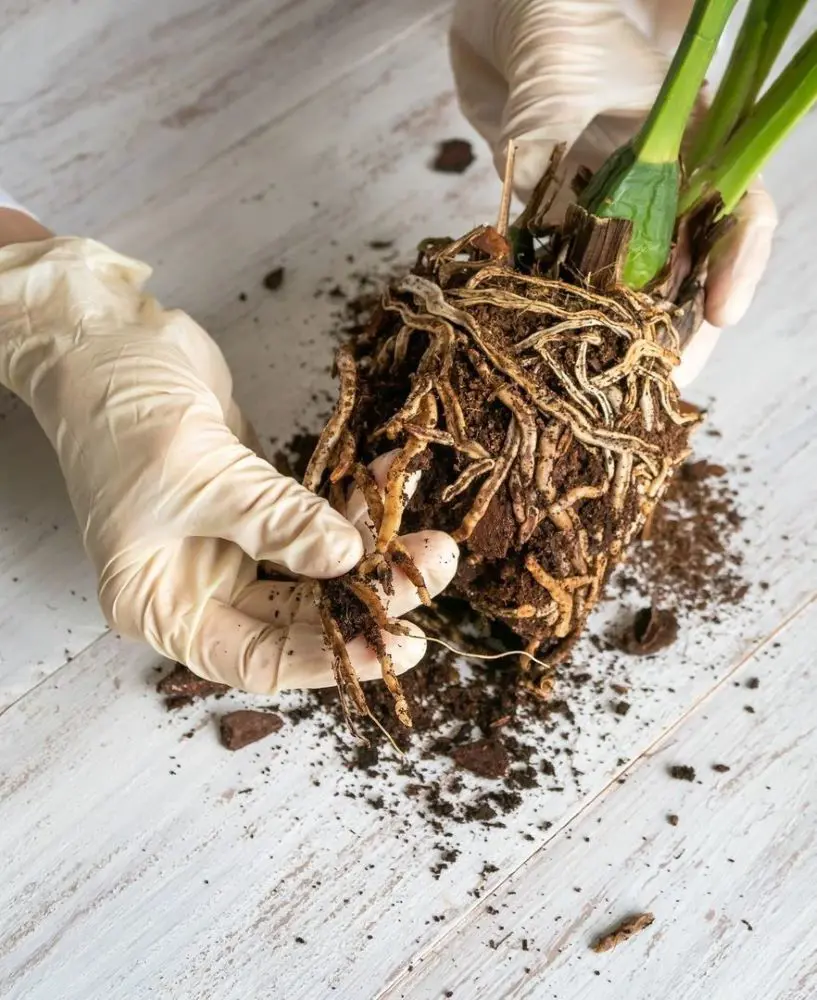Your Guide To Grow And Care Celosia Plant
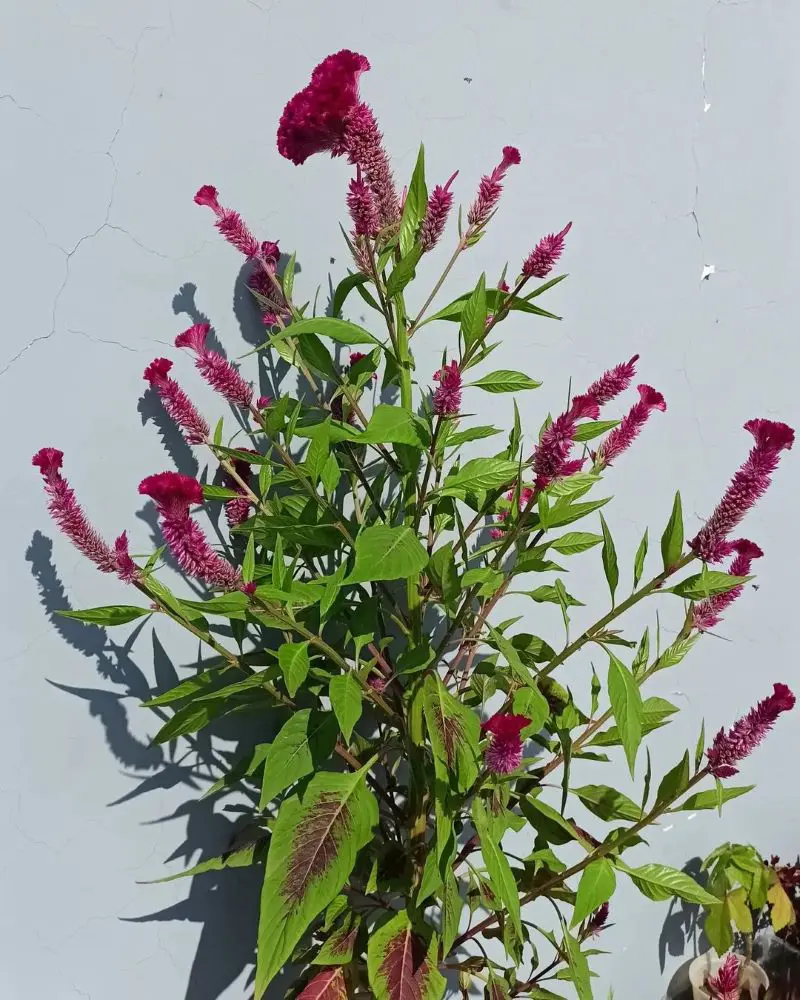
This post may contain affiliate links. If you make a purchase through links on our site, we may earn a commission.
Celosia is an edible plant native to the tropical regions of South America, Southeast Asia, and Africa, this plant is commonly grown with plants like marigolds, zinnia, sage, and more.
Beyond its aesthetic appeal, celosia is also popular for its use in the treatment of health conditions like headaches, ulcers, and carpal tunnel syndrome. Celosia is extremely easy to care for and we have made the process even easier with our guide below.
Celosia Overview
| Scientific Name | Celosia spp. |
| Common Names | Cockscomb, woolflowers |
| Family | Amaranthaceae |
| Type | Annual |
| Size | 4-36 in. tall, 12-24 in. wide |
| Sun Exposure | Full Sun |
| Soil Type | Tolerant of all soils with good drainage |
| Soil pH | Slightly acidic to slightly alkaline |
| Bloom Time | Summer through fall |
| Colors | Purple, burgundy, pink, white, yellow, red, orange |
| Hardiness Zones | 3-11 (USDA) (10-11 for perennial habit) |
| Native Area | Africa, North America, South America |
How To Grow Celosia Plant
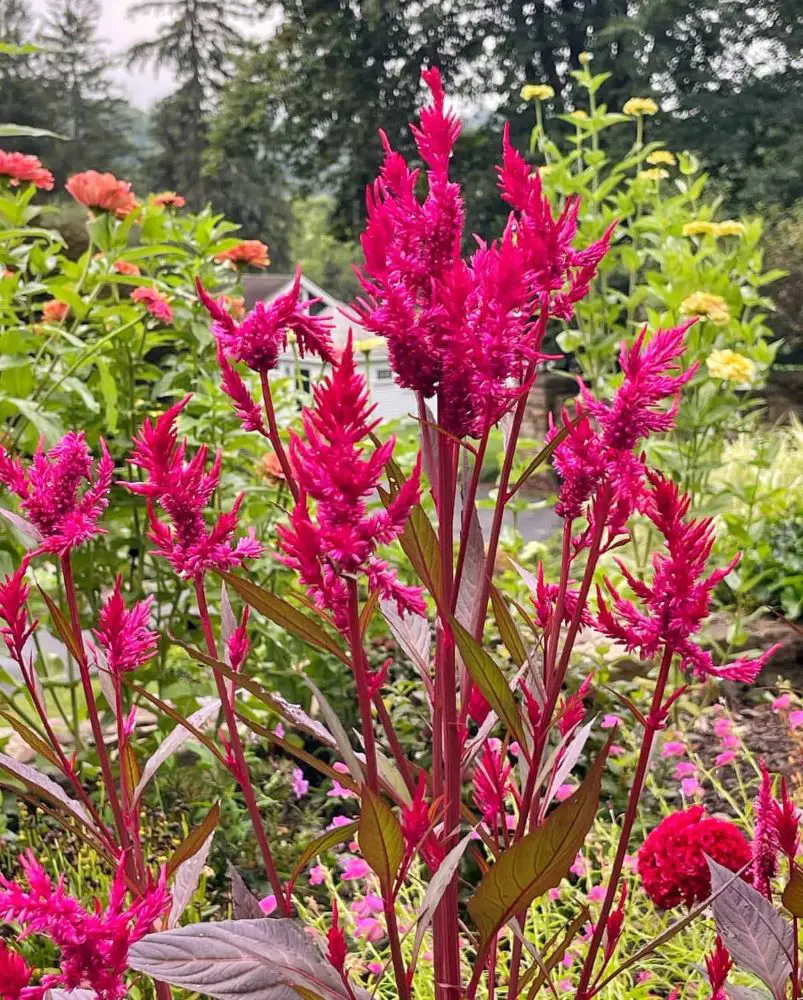
The celosia plant can be challenging to grow due to its sensitivity to overwatering, poor drainage, and fungal diseases. However, if the proper instruction is followed, gardeners can grow this plant with relative ease.
Common mistakes made by rookie gardeners include excessive watering, inadequate sunlight, and planting the celosia in compacted soil.
When To Plant
The celosia should be planted right after the last frost date in spring when the soil has warmed up. These plants thrive in warm temperatures, so planting when the risk of frost has passed ensures optimal growth conditions.
Make sure that the temperature is consistently above 50°F (10°C). This ensures the soil is warm enough for germination and growth. In warmer climates, celosia can also be planted in early spring or even late winter. Avoid planting during periods of extreme heat or cold for optimal establishment.
Where To Plant
The best location to plant celosia is in a spot with full sun exposure, receiving at least 6-8 hours of sunlight daily. It flourishes in well-drained soil with a slightly acidic to neutral pH.
Shelter the plant from strong winds as they can damage its delicate flowers. Also, adequate air circulation helps prevent fungal diseases, making an open, airy location preferable.
Depth, Support, And Spacing
Celosia seeds should be planted about 1/4 inch deep in well-draining soil. Once established, they typically don't require support unless growing particularly tall varieties, in which case stakes can be used.
Space plants about 12-18 inches apart to allow for proper airflow and prevent overcrowding to avoid diseases. Adequate spacing ensures each plant has enough room to develop fully and showcase its vibrant blooms.
Additional Growing Tips
Celosia are delicate plants with specific requirements for proper growth. These tips will help you regulate the plant's health to some extent.
- Regularly remove spent blooms to encourage continuous flowering throughout the season. Prevent the plant from putting energy into seed production.
- Apply a layer of organic mulch around the base of the plant to retain soil moisture, suppress weeds, and regulate soil temperature.
- Trim back any leggy or overgrown stems to maintain a compact, bushy growth habit and encourage branching.
- In regions with frost, grow the celosia plant as an annual. Meanwhile, in warmer climates, it may overwinter. Mulch around the base in colder months to protect the plant from freezing temperatures.
Celosia Care
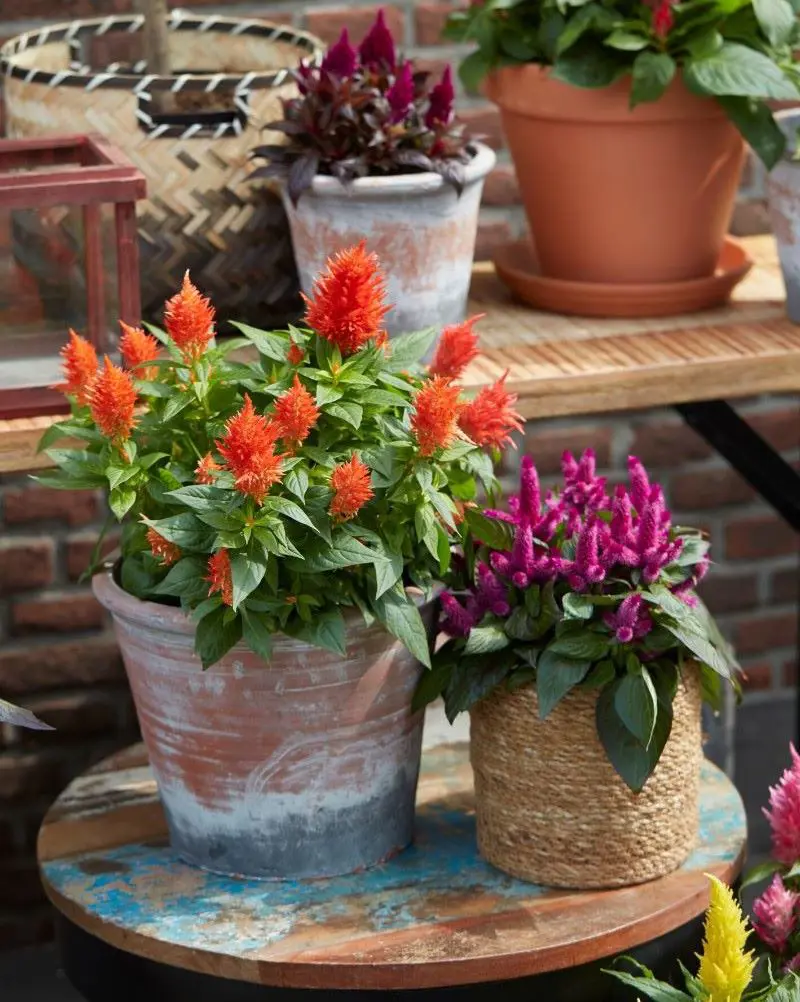
Caring for celosia is relatively easy; even beginners can successfully grow celosia and enjoy its vibrant blooms throughout the season. While it can be sensitive to overwatering and certain pests, proper attention to watering and pest management will easily solve this issue.
Light
Celosia plants need at least 6-8 hours of direct sunlight daily for optimal growth and flowering. Insufficient sunlight can lead to leggy growth and diminished blooming.
Placing them in a sunny location ensures vigorous growth, vibrant foliage, and abundant, long-lasting blooms.
Water
These plants prefer moderate and consistent watering. Water deeply when the soil feels dry to the touch, but avoid overwatering, which can cause root rot.
Moreover, ensure adequate drainage to prevent waterlogging. During hot weather, more frequent watering may be necessary to keep the soil evenly moist. Avoid overhead watering to prevent fungal diseases.
Soil
Celosia requires well-draining soil with a slightly acidic to neutral pH. It prefers soil that is rich in organic matter, providing nutrients for healthy growth.
Avoid heavy or compacted soil as it can lead to poor drainage and root rot. Amending soil with compost can improve fertility and structure, ensuring optimal conditions for celosia to flourish.
Temperature
Maintain an ideal temperature between 70-85°F (21-29°C) for the proper growth of the Celosia. The plant is sensitive to cold temperatures and frost, which can damage or kill the plant.
Planting after the last frost date in spring ensures optimal growth conditions. Protect from extreme heat by providing adequate hydration and shading during peak sun hours.
Humidity
Celosia plants prefer moderate humidity levels between 40-60%. High humidity combined with poor air circulation can lead to fungal diseases, so it's essential to maintain good airflow around the plants.
In drier climates, occasional misting can help increase humidity levels and promote healthy growth.
Fertilizer
These flower plants need a balanced fertilizer, such as a 10-10-10 or 20-20-20 formulation. Additionally, they respond well to fertilizers high in phosphorus, which promotes blooming.
Apply fertilizer according to package instructions, typically every 4-6 weeks during the growing season. Avoid over-fertilizing as it can lead to excessive foliage growth at the expense of flowers.
Propagating Celosia
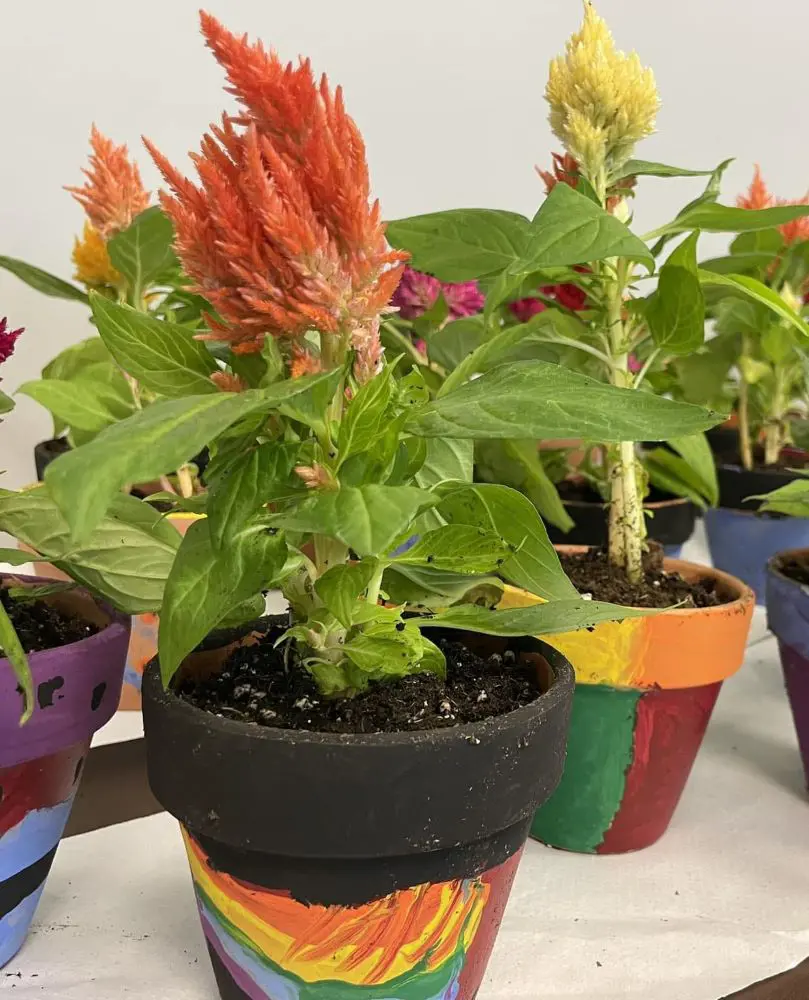
Celosia can be propagated through seeds, cuttings, and division. When done correctly, it will ultimately result in the growth of healthier plants.
Seeds offer genetic diversity, while cuttings and division produce clones of the parent plant. Proper care during propagation includes providing optimal growing conditions and disease prevention measures.
Propagation By Cuttings
Propagation of celosia by cuttings requires taking a stem cutting from a healthy plant. Here is a step-by-step guide on how to propagate the plant by cuttings.
- Select a Healthy Plant: Choose a mature, healthy celosia plant with vigorous growth and no signs of disease or pests.
- Prepare Equipment: Gather a sharp, clean pair of scissors or pruning shears, a small pot filled with well-draining potting mix, and a misting bottle.
- Take a Cutting: Using the scissors or shears, cut a 4-6 inch section of stem from the parent plant. Cut just below a leaf node, which is where new roots will emerge.
- Remove Lower Leaves: Strip away the lower leaves from the cutting, leaving only a few leaves at the top to reduce moisture loss.
- Plant the Cutting: Insert the cut end of the stem into the potting mix, burying it about 1-2 inches deep. Gently firm the soil around the cutting to hold it upright.
- Provide Adequate Conditions: Place the pot in a warm, bright location with indirect sunlight. Keep the soil consistently moist but not waterlogged.
- Encourage Root Growth: To encourage root development, mist the cutting regularly to maintain high humidity around the leaves.
- Monitor Growth: Check the cutting regularly for signs of new growth, such as emerging leaves or roots. This typically occurs within 2-4 weeks.
- Transplant: Once the cutting has developed a healthy root system, usually indicated by roots emerging from the drainage holes at the bottom of the pot, it's ready to transplant into a larger container or the garden.
- Care for Newly Rooted Plant: Continue to provide proper care for the newly rooted celosia plant, including regular watering, fertilization, and protection from pests and diseases.
Propagation By Division
Propagating celosia by division involves separating the roots of an established plant into smaller sections, each with its own shoot or growth point. This method creates new plants with identical genetic traits to the parent plant and is typically done in spring or early summer for best results.
- Choose a Mature Plant: Select a healthy, mature celosia plant with well-established roots and multiple shoots.
- Prepare the Plant: Water the plant thoroughly a day before dividing to ensure the soil is moist and easier to work with.
- Dig up the Plant: Carefully dig around the base of the plant, loosening the soil to expose the root system.
- Separate the Roots: Gently tease apart the roots, dividing the plant into smaller sections. Each section should have its own set of roots and shoots.
- Trim Excess Roots: If necessary, trim any excessively long or damaged roots with clean, sharp scissors or pruning shears.
- Plant Divisions: Replant the divided sections in prepared soil in pots or directly in the garden. Ensure the soil is well-draining and firm around the roots.
- Water and Mulch: Water the newly planted divisions thoroughly to settle the soil around the roots. Apply a layer of mulch to help retain moisture and suppress weeds.
- Provide Care: Place the divisions in a location with partial sun to allow them to establish without stress. Keep the soil consistently moist but not waterlogged.
- Monitor Growth: Monitor the divisions regularly for signs of new growth, indicating successful establishment. Avoid disturbing the plants while they are establishing roots.
How To Grow Celosia From Seed
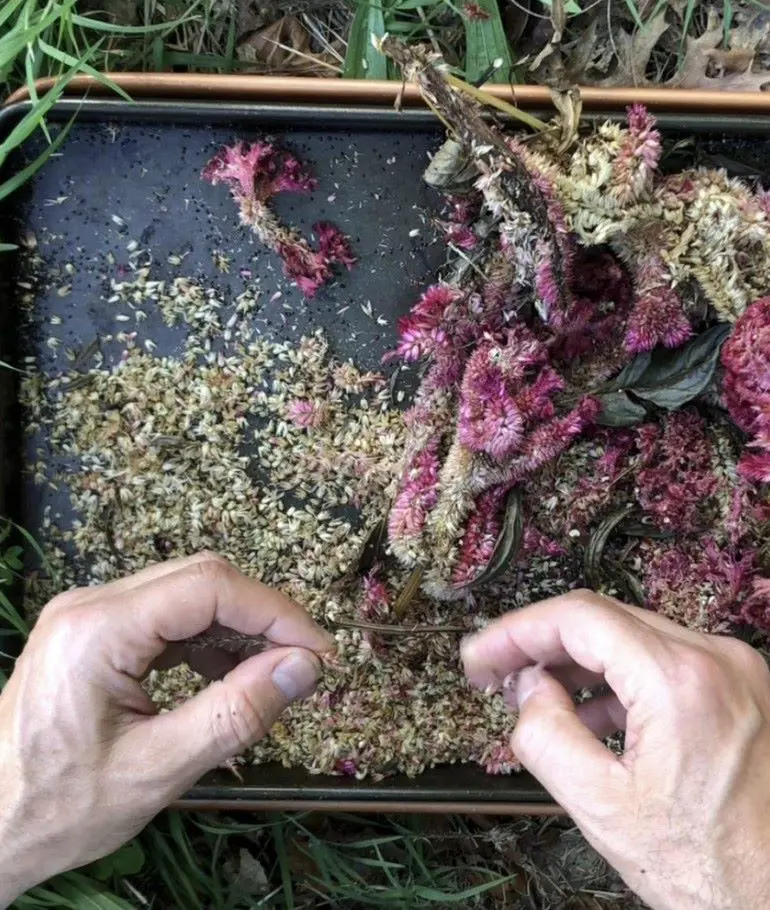
Growing celosia from seeds is a rewarding process that allows for a wide variety of colors and forms. This task is normally started indoors during winter, before the last frost. With proper care and attention, seeds quickly germinate and produce vigorous, blooming plants.
The process for growing these exotic plants from seeds is summarized below:
- Choose high-quality celosia seeds from a reputable supplier, considering the variety and color preferences.
- Start seeds indoors 6-8 weeks before the last frost date in your area or sow directly in the garden after the danger of frost has passed.
- Fill seed trays or small pots with a well-draining seed starting mix.
- Plant 2-3 seeds per pot, pressing them lightly into the soil surface. Cover with a thin layer of soil.
- Water the soil gently until it's evenly moist. Avoid waterlogging as excess moisture can lead to damping off.
- Place the seed trays in a warm location with indirect sunlight. Keep the soil consistently moist but not soggy.
- Once seedlings emerge, provide them with bright, indirect light. Thin out weaker seedlings, leaving the strongest one per pot.
- When seedlings have developed 2-3 true leaves, transplant them into larger containers or the garden, spacing them 12-18 inches apart.
- If started indoors, gradually acclimate seedlings to outdoor conditions by placing them outdoors for increasingly longer periods over 7-10 days.
- Choose a sunny location with well-draining soil. Plant seedlings at the same depth as they were in their containers and water thoroughly after planting.
- Apply a balanced fertilizer every 4-6 weeks to encourage healthy growth and flowering.
- Allow some flowers to mature and dry on the plant. Collect seeds once the flower heads have turned brown and dry.
Celosia Types
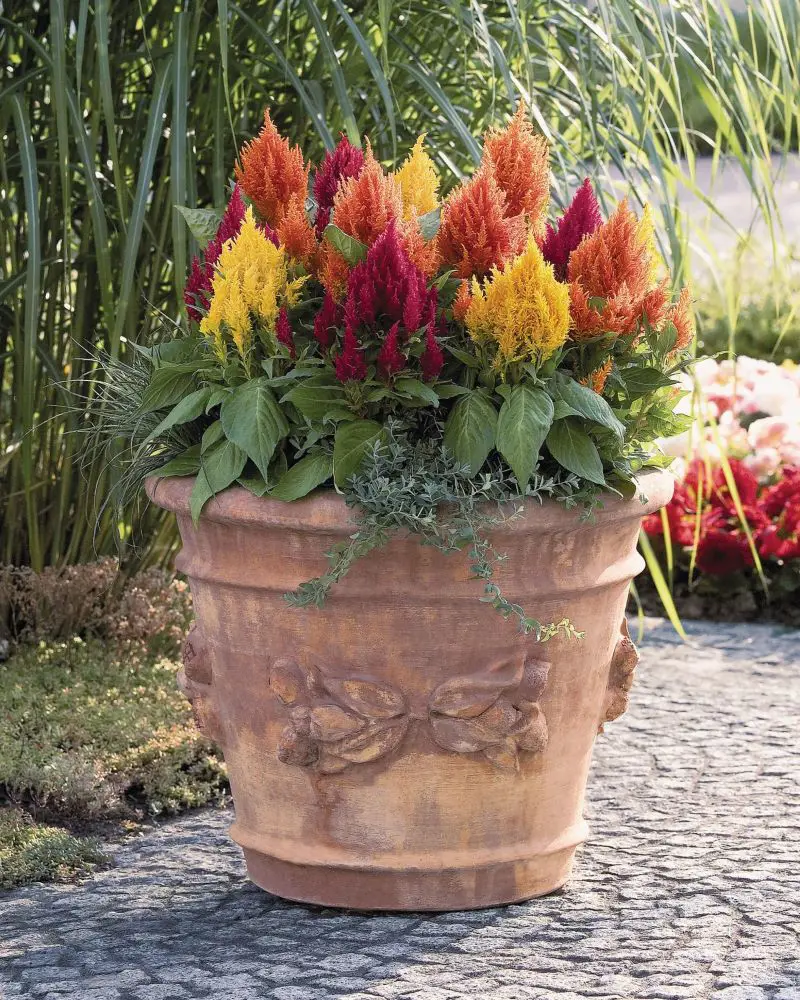
The Celosia plant has around 50 different types, each featuring a different set of characteristics. Varieties like cockscomb and plumed celosia are common and often found growing in gardens.
1. Cockscomb Celosia
Cockscomb celosia (Celosia cristata) is renowned for its striking, crested flower heads that resemble rooster combs. Available in vibrant shades of red, orange, yellow, and pink, it adds a bold splash of color to gardens and floral arrangements. This heat-tolerant annual thrives in full sun and well-drained soil, making it a popular choice for summer gardens.
2. Plumed Celosia
Plumed celosia (Celosia plumosa) is characterized by its elegant, feathery plumes of flowers that gracefully sway in the breeze. It is found in an array of vivid colors such as red, pink, purple, and white. This variety adds a touch of softness and texture to garden beds, borders, and cut flower arrangements. It thrives in full sun and well-drained soil.
3. Wheat Celosia
Wheat celosia (Celosia argentea var. spicata) is named for its resemblance to wheat spikes. This variety features compact, upright flower heads that resemble spikes, available in vibrant hues of red, orange, and yellow. Its unique appearance adds visual interest to garden beds and floral displays.
4. Silver's Cockscomb
Also known as Celosia argentea var. cristata 'Silver,' this is a unique cultivar distinguished by its silvery-gray foliage and vibrant, crested flower heads. These flower heads resemble rooster combs and come in various colors such as red, orange, and yellow.
Silver's Cockscomb adds a striking contrast to garden beds and containers, enhancing visual appeal.
5. Silver Spinach
The Silver Spinach celosia, also known as Celosia argentea 'Silver Spinach,' is characterized by its attractive silvery-gray foliage resembling spinach leaves. This variety brings a unique texture and color contrast to garden landscapes and floral arrangements. Though primarily grown for its foliage, it may also produce small, inconspicuous flowers.
Companion Plants
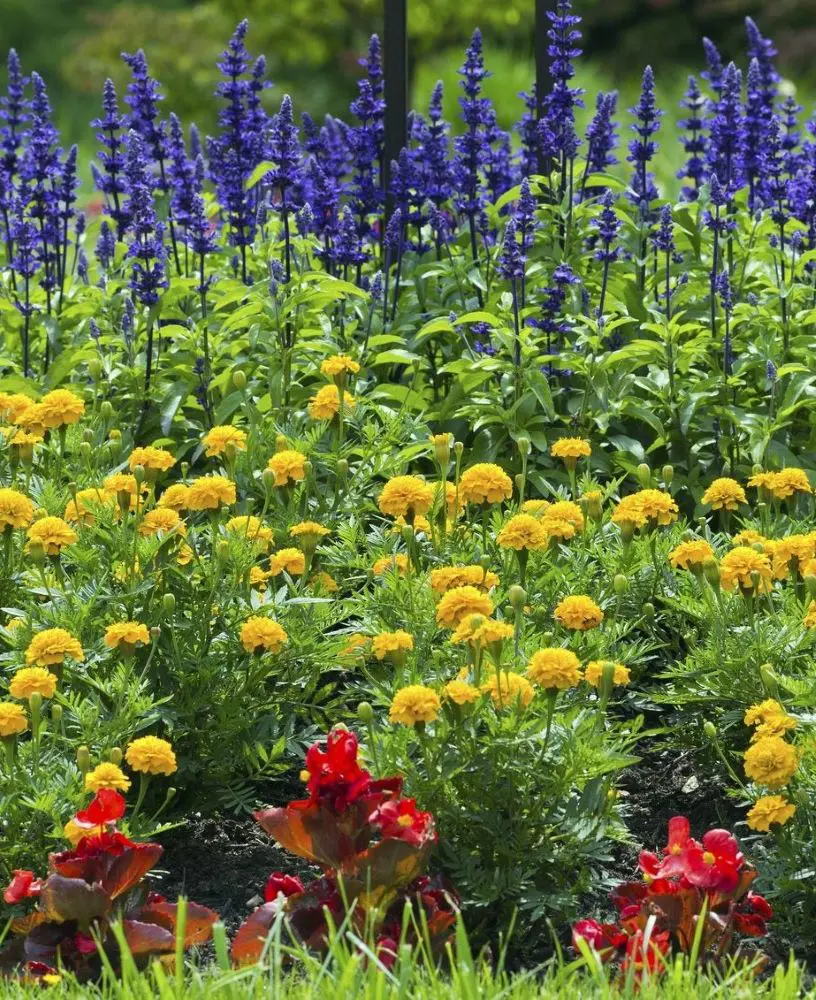
The celosia is non-invasive, meaning it can grow in harmony with other plants. Some common celosia companion plants include marigolds, petunias, zinnia, salvia, and more.
Marigold
Marigolds are annual flowers known for their vibrant colors and strong fragrance. They deter pests like nematodes and offer continuous blooms throughout the growing season. Paired with celosia, marigolds not only add complementary colors but also provide pest protection.
Petunia
Petunias are popular annual flowers prized for their abundant and colorful blooms. They come in various colors and patterns, offering versatility in garden designs.
Petunias thrive in full sun and well-drained soil, blooming continuously throughout the growing season. With their vibrant colors and trailing habits, they make excellent companions to celosia.
Zinnia
Zinnias (Zinnia spp.) pair harmoniously with celosia plants, offering a diverse range of colors, heights, and flower forms. Their prolific blooms attract pollinators and provide a vibrant backdrop to celosia's unique textures.
Both plants thrive in full sun and well-drained soil, making them complementary companions for creating eye-catching displays.
Common Pests And Diseases
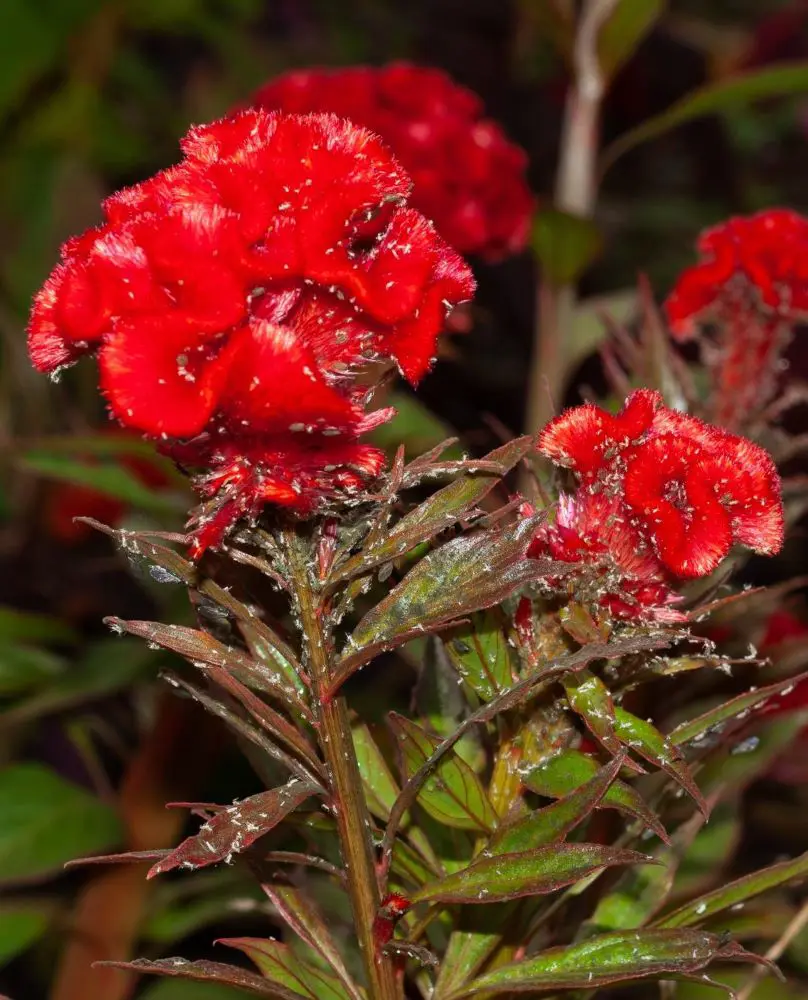
Celosia plants are generally healthy when grown in well-drained soil under favorable conditions. However, they can be susceptible to certain pests and diseases. Common pests include aphids, spider mites, and caterpillars, which can feed on foliage and flowers. Additionally, fungal diseases like powdery mildew and damping-off can occur, particularly in humid conditions or when plants are overcrowded.
Aphids
Aphids feed on the sap of celosia plants, causing distorted growth, yellowing leaves, and stunted development. Additionally, aphids secrete honeydew, attracting ants and promoting the growth of sooty mold.
Solution: Use insecticidal soap or neem oil, spray the affected plants thoroughly, and repeat as needed until the infestation is controlled.
Spider Mites
Spider mites are tiny pests that feed on plant sap, causing stippling, yellowing leaves, and webbing on celosia plants. Severe infestations can weaken and stunt growth.
Solution: Rinse the plants with a strong jet of water to dislodge the mites, apply insecticidal soap or neem oil, and ensure proper plant hygiene and environmental conditions to discourage further infestation.
Powdery Mildew
This disease is caused by fungal spores that thrive in warm, humid conditions. It appears as a white powdery coating on leaves and stems, leading to leaf distortion and reduced vigor.
Treatment: Apply fungicidal sprays containing sulfur or potassium bicarbonate, ensure proper air circulation, and avoid overhead watering to reduce humidity around the plant.
Botrytis Blight
Caused by the fungus Botrytis cinerea, this disease leads to grayish-brown lesions on leaves, stems, and flowers. It thrives in cool, humid conditions, often appearing after periods of rain or high humidity.
Treatment: Remove and destroy infected plant parts, improve air circulation, avoid overhead watering, and apply fungicidal sprays containing thiophanate-methyl or chlorothalonil.
Recent posts
Plant Care
Plant Care
How To Plant, Grow and Care Majesty Palm
The majestic palm, scientifically known as Ravenea rivularis, makes for a stunning indoor tree with its lush and grand fronds. Originating from Madagascar's river banks, this resilient houseplant is cherished not only for its beauty but also for its ...
Plant Care
How To Grow And Care For A Hosta Plant
Hosta plants are widespread perennials, often grown for their beautiful and diverse foliage. They are extremely easy to care for and can thrive in various conditions, particularly shade or semi-shade. These hardy plants can last for many years and re...

